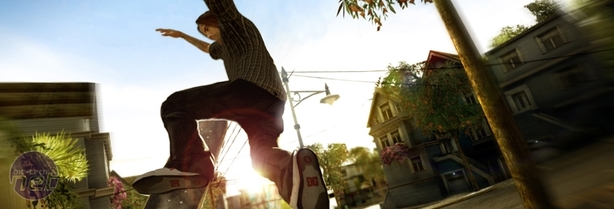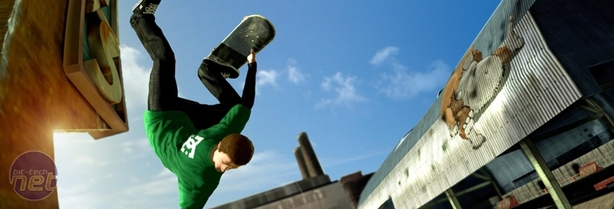
Hands-On
One of the major new features in Skate 2 is the fact you can explore your environment on foot. Good, great – that’s been done in skateboarding games for a while now.Skate 2 however takes it a step further and introduces the ability to actually manipulate the environment in real-time – which is something pretty new and special.
Let’s be clear too that this isn’t a matter of switching over to a level editor or having your view zoomed and turned isometric. Those kind of level editors have been tried before and proved to be at odds with the casual appeal and pick-up-and-play gameplay of what is at its heart a sports game.
Instead of this, Skate 2 offers a more hands-on solution. Literally; hands-on. When you jump off your board you’re free to roam around the level as you will jumping and climbing and all sorts, but interacting with your surroundings isn’t limited to just climbing walls and using elevators; you can actually pick up, drag and shift all the various ramps and rails that make up the level.
Well, actually that’s not entirely true. There is a level of stubbornness on the levels behalf and you won’t be able to shift objects that are clearly fixed to a single position. Flights of stairs, lampposts and weird-ass modern art sculptures are among the items that’ll be fixed in place, though most everything else is to be considered fair game. In short, anything that isn’t nailed down can or cemented can be picked up.
Strangely though, the physics system for the game actually seems hugely loose in the player interactions and as soon as you hop off your board then the virtual world transforms into one where everything weighs about as much as a photograph of itself. You can heft ramps twice the size of a dumper truck with no problem whatsoever, whizzing them across the wrecked car parks and cityscape faster than greased-up pig.
The good news though is that, although it sounds a bit stupid, it actually works better that way and the developers assured us that it was a deliberate and concious choice to make the player so inhumanly strong. The idea of being able to move the ramps and rails and so on is that you can actually do it – adding realistic weight in as a limitation is more of an annoyance and a barrier to the player.
If it really bothers you then just pretend that your skater is a cyborg. That’s what we did and it certainly did a lot to help explain why there’s no spraying blood or jutting, broken bones when you do a particularly spectacular bail.
Annoyingly though, our hands-on experimentation with this side of the game proved to be a slightly wonky representation of how the final game should be. We were assured that by the time the game ships players will be able to enjoy a bug-free and seamless game with realistic collision detection to a degree. As it was though, our experience had moveable rails occasionally clipping through walls and other in-game items, often falling over and proving difficult to correct. Frustrating – but this isn’t even in its beta stage yet and EA is at least aware of and eager to fix the problem.
Still, even in this slightly borked state, the option to alter the position of items is incredibly useful and powerful. We did for example see one game journo set up an especially creative line of tricks with a long, straight rail leading up a lunch table and another down the other side, with a small gap between the two lines.
After a little bit of practice it was pretty impressive to watch people successfully do a brief 50-50 up first rail before hopping off, footplanting the centre of the table and nose-grinding down the downwards rail and ending the trick with a manual-to-handplant combo at a nearby bowl. Stunning.
This new ability to set up your own trick lines, combined with the still-present and improved Session Marker system from the first game which lets players set a checkpoint that they can reset to if they want, means that you can set-up some truly impressive challenges for yourself and then spend as long as you want refining them.

MSI MPG Velox 100R Chassis Review
October 14 2021 | 15:04











Want to comment? Please log in.